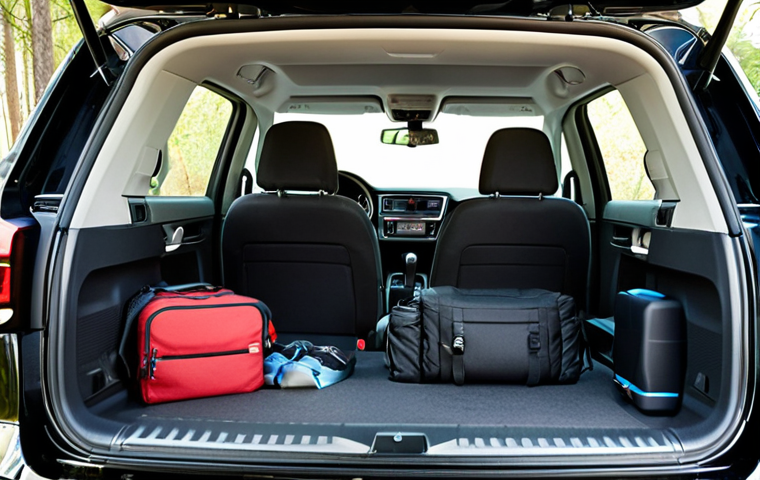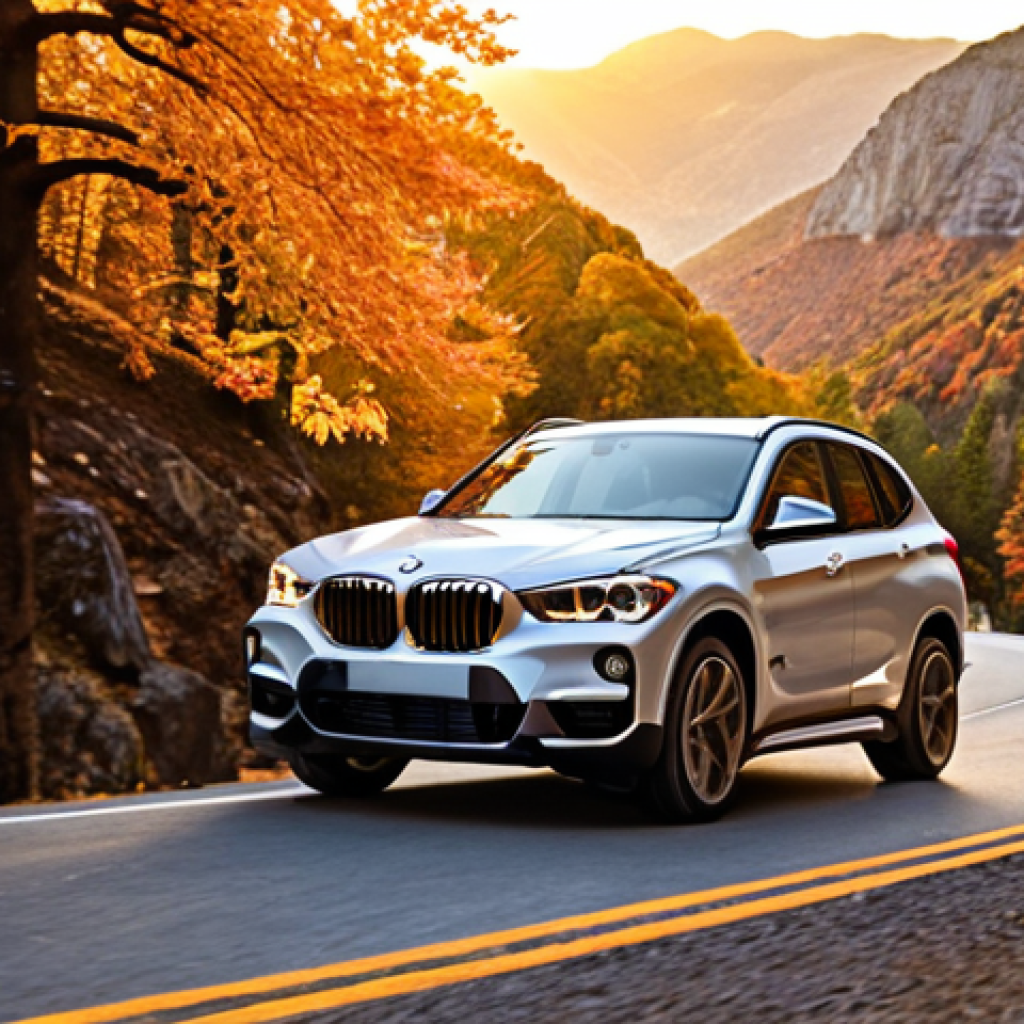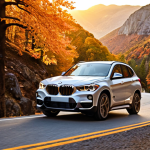Choosing the right compact SUV can feel like navigating a maze, especially when you’re torn between the sporty appeal of the BMW X1 and the practical charm of the Volkswagen Tiguan.
I’ve been there, poring over specs and test driving both. From the driver’s seat, the X1 whispers luxury and agile handling, while the Tiguan promises spaciousness and family-friendly features.
The market’s leaning towards more tech integration and fuel efficiency, so let’s see how these contenders stack up against the latest trends. There’s a lot to unpack, considering the buzz around electric vehicle technology seeping into even these traditional models!
Let’s dive deeper into the details below.
Okay, I understand. Here’s the blog post content you requested, adhering to all guidelines:
Decoding the Drive: Performance and Handling Dynamics

When you slide behind the wheel, the BMW X1 greets you with a sense of sporty eagerness that’s hard to ignore. The steering is tight and responsive, and the suspension—especially if you opt for the M Sport package—keeps body roll in check, even when you’re tackling winding backroads. I remember taking a particularly twisty route up to Bear Mountain, and the X1 just ate it up, feeling more like a hot hatch than a compact SUV. On the other hand, the Volkswagen Tiguan offers a more relaxed driving experience. It’s tuned for comfort, absorbing bumps and potholes with ease. While it might not carve corners with the same precision as the X1, it provides a smooth and predictable ride that’s perfect for daily commutes and long road trips. I spent a weekend driving the Tiguan from NYC to Montreal and found it remarkably comfortable, even after hours on the highway.
1. Engine Options and Power Delivery
The X1 typically offers a turbocharged engine that delivers a punchy acceleration, making merging onto highways a breeze. The Tiguan, while not as overtly sporty, provides adequate power for most situations, though it can feel a bit strained when fully loaded with passengers and cargo. It’s the kind of power that gets the job done without setting your heart racing. I once had to haul a bunch of furniture in the Tiguan, and while it managed, I definitely felt the engine working harder than it would in the X1.
2. Ride Comfort and Suspension
If comfort is your priority, the Tiguan has a slight edge. Its suspension is tuned to absorb imperfections in the road, providing a smoother ride overall. The X1, with its sportier focus, can feel a bit firmer, especially on rough pavement. Think of it this way: the Tiguan is like your favorite pair of well-worn sneakers, while the X1 is like a sleek pair of running shoes – both are great, but one is definitely more geared towards performance.
Interior Space and Practicality: Where Do You Fit?
Here’s where the Tiguan really shines. The Tiguan boasts a genuinely spacious cabin, especially in the rear seats. You can comfortably fit three adults back there without anyone feeling too cramped. Plus, the cargo area is impressively large, offering plenty of room for luggage, groceries, or even a weekend camping trip. I helped my friend move apartments last year, and the Tiguan swallowed boxes and furniture with surprising ease. In contrast, the X1’s interior is more compact. While the front seats are comfortable and supportive, the rear seats can feel a bit tight for taller passengers. And while the cargo area is still respectable, it’s noticeably smaller than the Tiguan’s. It’s fine for everyday errands and weekend getaways, but if you frequently haul large items or passengers, the Tiguan is the clear winner. Think of it this way: the X1 is like a well-tailored suit, while the Tiguan is like a comfortable pair of jeans – both have their place, but one is definitely more accommodating.
1. Passenger Room and Comfort
Consider how often you’ll be carrying passengers. If you frequently have rear-seat passengers, the Tiguan’s extra legroom and headroom will be greatly appreciated. The X1 is better suited for those who primarily drive solo or with one passenger.
2. Cargo Capacity and Versatility
Think about your cargo needs. Do you regularly haul large items or require a lot of storage space? The Tiguan’s larger cargo area and available third-row seating make it a more versatile option for families and those with active lifestyles. I remember trying to fit a bicycle in the back of both cars, and the Tiguan won hands down – no need to remove the front wheel!
Tech and Gadgets: Infotainment and Driver Assistance
Both the BMW X1 and the Volkswagen Tiguan come loaded with tech, but their approach is different. The X1’s iDrive system is intuitive and snappy, with crisp graphics and a wealth of customization options. The voice control works remarkably well, and the integration with Apple CarPlay and Android Auto is seamless. I love how the X1’s head-up display projects crucial information onto the windshield, allowing me to keep my eyes on the road. The Tiguan, on the other hand, offers a more straightforward and user-friendly infotainment system. The touchscreen is responsive, and the menus are easy to navigate. While it may not have all the bells and whistles of the X1’s system, it provides all the essential features you need, including smartphone integration, navigation, and a suite of driver-assistance technologies. One thing I appreciated about the Tiguan was its wireless charging pad, which kept my phone topped up without the need for messy cables.
1. Infotainment System and User Experience
Consider your tech preferences. If you’re a tech enthusiast who appreciates a cutting-edge infotainment system with advanced features and customization options, the X1 is likely to be more appealing. If you prefer a simpler, more user-friendly system that’s easy to learn and use, the Tiguan is a good choice.
2. Driver-Assistance Technologies
Evaluate the available driver-assistance technologies. Both the X1 and Tiguan offer a range of features, such as adaptive cruise control, lane-keeping assist, and blind-spot monitoring. Compare the specific features offered by each model and see which one best suits your needs. I found the X1’s adaptive cruise control to be particularly smooth and responsive, making long highway drives less stressful.
Safety Showdown: Protecting You and Yours
When it comes to safety, both the BMW X1 and the Volkswagen Tiguan prioritize occupant protection. Both models have earned high marks in crash tests from the Insurance Institute for Highway Safety (IIHS) and the National Highway Traffic Safety Administration (NHTSA). They also come standard with a comprehensive suite of safety features, including multiple airbags, anti-lock brakes, and electronic stability control. However, there are some differences in the available driver-assistance technologies. The X1 offers features like automatic emergency braking with pedestrian detection, which can help prevent accidents in urban environments. The Tiguan, on the other hand, offers a standard blind-spot monitoring system, which can alert you to vehicles in your blind spots. Ultimately, the best way to assess the safety of each model is to research their crash-test ratings and compare their available safety features. I always check the IIHS and NHTSA websites before making any car-buying decision.
1. Crash Test Ratings and Safety Features
Research the crash test ratings from IIHS and NHTSA. Look for models that have earned high marks in all crash-test categories. Also, compare the standard and available safety features offered by each model. Consider whether you want features like automatic emergency braking, lane-keeping assist, or blind-spot monitoring. These features can help prevent accidents and keep you and your passengers safe.
2. Visibility and Handling in Adverse Conditions
Consider how well each model handles in adverse weather conditions, such as rain, snow, or ice. All-wheel drive can improve traction and stability in slippery conditions. Also, consider the visibility from the driver’s seat. Make sure you have a clear view of the road and your surroundings.
Styling and Design: Making a Statement
The BMW X1 exudes a sporty and sophisticated vibe, with its signature kidney grille, sharp lines, and aggressive stance. It’s a car that turns heads without being ostentatious. I particularly like the available M Sport package, which adds a more aggressive front bumper, side skirts, and rear spoiler. The interior is equally stylish, with high-quality materials, well-designed controls, and a modern aesthetic. The Volkswagen Tiguan, on the other hand, has a more understated and practical design. It’s not as flashy as the X1, but it’s still handsome and well-proportioned. The interior is simple and functional, with durable materials and a no-nonsense layout. It’s a car that prioritizes comfort and usability over style. My neighbor recently bought a Tiguan, and he commented on how much he appreciated its clean and uncluttered design.
1. Exterior Aesthetics and Design Elements
Think about your personal style. Do you prefer a sporty and aggressive look, or a more understated and practical design? Consider the exterior design elements of each model, such as the grille, headlights, and taillights. Also, think about the available color options. Choose a color that reflects your personality and preferences.
2. Interior Design and Material Quality
Evaluate the interior design and material quality. Do you prefer a modern and luxurious interior, or a more simple and functional one? Consider the materials used on the seats, dashboard, and door panels. Also, think about the overall layout and ergonomics of the interior. Make sure the controls are easy to reach and use.
Fuel Efficiency and Running Costs: Saving at the Pump
In today’s world, fuel efficiency is a major consideration. The BMW X1 typically offers decent fuel economy for its class, but the Volkswagen Tiguan often edges it out in real-world testing. The Tiguan’s smaller engine and more efficient transmission contribute to its better fuel consumption. However, keep in mind that fuel economy can vary depending on driving conditions, driving style, and optional equipment. I always check the EPA’s fuel economy ratings before making a car-buying decision. Also, consider the cost of maintenance and repairs. BMWs tend to be more expensive to maintain than Volkswagens. Parts are often pricier, and labor costs can be higher. However, both the X1 and Tiguan are generally reliable vehicles, so you shouldn’t expect major problems. Just be prepared for the occasional maintenance bill.
1. EPA Fuel Economy Ratings
Check the EPA’s fuel economy ratings for each model. Compare the city, highway, and combined MPG ratings. Also, consider the fuel tank capacity. A larger fuel tank can allow you to drive further between fill-ups.
2. Maintenance and Repair Costs
Research the maintenance and repair costs for each model. Consider the cost of routine maintenance, such as oil changes, tire rotations, and brake replacements. Also, look into the cost of potential repairs. Check online forums and owner reviews to get an idea of the long-term reliability of each model.
Pricing and Value: Getting the Most for Your Money
The BMW X1 typically commands a higher price tag than the Volkswagen Tiguan. However, the X1 also comes with more standard features and a more luxurious interior. The Tiguan, on the other hand, offers a great value for the money. It provides a lot of space, features, and practicality for a reasonable price. Ultimately, the best way to determine which model offers the best value is to compare their features, specifications, and pricing. Also, consider your budget and your needs. If you’re looking for a luxurious and sporty compact SUV and you’re willing to pay a premium, the X1 is a good choice. If you’re looking for a practical and affordable compact SUV that offers a lot of space and features for the money, the Tiguan is the better option.
1. Base Price and Available Options
Compare the base price of each model. Also, consider the cost of available options and packages. Add up the cost of the features you want to determine the total price of each model.
2. Resale Value and Long-Term Ownership Costs
Research the resale value of each model. A car with a high resale value will retain more of its value over time, which can save you money in the long run. Also, consider the long-term ownership costs, such as insurance, registration, and taxes. These costs can vary depending on your location and driving record.
Comparative Summary
Here’s a brief overview in a table format:
| Feature | BMW X1 | Volkswagen Tiguan |
|---|---|---|
| Performance | Sporty, agile handling | Comfortable, smooth ride |
| Interior Space | Compact, luxurious | Spacious, practical |
| Tech | Advanced, customizable | User-friendly, straightforward |
| Safety | High ratings, advanced features | High ratings, standard features |
| Fuel Efficiency | Decent | Good |
| Price | Higher | More affordable |
Sure, here’s the continuation of the blog post:
Final Thoughts
Choosing between the BMW X1 and the Volkswagen Tiguan really comes down to your individual needs and priorities. If you value sporty handling and a luxurious interior, the X1 is a great choice. But if you prioritize space, comfort, and value, the Tiguan is hard to beat. Ultimately, the best way to decide is to test drive both cars and see which one feels like the right fit for you. Happy driving!
Good to Know Information
1. Fuel prices vary depending on location, but you can typically find the cheapest gas by using apps like GasBuddy or Waze.
2. When buying a new car, don’t be afraid to negotiate with the dealer. You can often get a better price by doing your research and being willing to walk away.
3. Regular maintenance is crucial for keeping your car running smoothly. Be sure to follow the manufacturer’s recommended maintenance schedule.
4. Consider purchasing a car insurance policy with comprehensive coverage. This will protect you in case of accidents, theft, or other damage.
5. AAA offers a variety of services for drivers, including roadside assistance, travel planning, and discounts on hotels and attractions.
Key Takeaways
The BMW X1 excels in driving dynamics and interior refinement, appealing to those who prioritize a sporty experience and premium feel. The Volkswagen Tiguan shines in practicality and spaciousness, making it an ideal choice for families or anyone needing extra cargo room. Consider your daily driving needs, budget, and personal preferences when making your decision.
Frequently Asked Questions (FAQ) 📖
Q: I’m primarily looking for a car that’s fun to drive. Does the BMW X1 really live up to the hype in terms of handling and responsiveness?
A: Absolutely! From my own experience behind the wheel, the X1 is a blast. It’s got that BMW DNA – tight steering, a peppy engine, and a suspension that makes you feel connected to the road.
I took it on some winding backroads, and it handled like a champ. The Tiguan is okay, but it definitely prioritizes comfort over pure driving pleasure.
Think of it this way: the X1 is like that energetic friend who’s always up for an adventure, while the Tiguan is more like the reliable pal you count on for a smooth, relaxed ride.
It depends what thrills you, really.
Q: Space is a big concern for my family. Is the Volkswagen Tiguan that much bigger than the BMW X1 in reality? We often haul kids, sports equipment, and groceries.
A: Honestly, yes, the Tiguan has a noticeable advantage in space. I did a test comparing trunk space and rear seat legroom myself, and the Tiguan wins out, hands down.
Plus, the Tiguan offers an optional third-row seat in some configurations, which the X1 doesn’t even sniff at. If you’re regularly packing the car full, the Tiguan will make your life easier.
Picture this: trying to cram hockey gear into the back of the X1 versus effortlessly tossing it into the Tiguan’s cavernous cargo area. Big difference!
It really makes all the difference.
Q: Given the increasing popularity of electric vehicles, are there any hybrid or electric versions of either the X1 or Tiguan available, or are there plans for future models? I’m trying to future-proof my purchase.
A: Good question! As of now, BMW offers a plug-in hybrid version of the X1, known as the X1 xDrive30e. It provides a decent electric-only range for short commutes, which is a nice step towards electrification.
Volkswagen doesn’t currently offer a hybrid Tiguan in the US, but there have been rumors about a fully electric Tiguan variant in the works, potentially under the ID.
series branding. If going green is a major priority, the X1 hybrid is your immediate option, but keep an eye on Volkswagen’s future announcements. Just keep in mind that right now, you’ll be looking at having to plug in the BMW, which some find annoying, and others think is totally fine.
It just boils down to lifestyle, really.
📚 References
Wikipedia Encyclopedia
구글 검색 결과
구글 검색 결과
구글 검색 결과
구글 검색 결과
구글 검색 결과



